
Cubs News: Dissecting the Jason Heyward $184 million contract |
Jason Heyward was the crown jewel in a 2015 offseason that set the Chicago Cubs up for a curse-breaking World Series title the following season. His eight-year $184 million deal has been widely debated since the ink dried on the contract. With change coming in the organization, it’s time for the Cubs to look back at this contract and decide what kind of value will Heyward have going forward.
Since his first season with the Cubs, Heyward’s offense, or lack thereof, has been the biggest talking point. Before signing with the Cubs, Heyward was a good but not great hitter. His .784 OPS from 2010-2015 ranked 79th in the MLB among qualified hitters. Offensively, he was in the same OPS range as Todd Frazier and Dexter Fowler. The most promising aspect of Heyward’s offense was his contact ability. Through five seasons with the Atlanta Braves, Heyward produced a .262 average with a 19.3% strikeout rate. After being traded to the St. Louis Cardinals, Heyward posted a career-high average of .293 and a strikeout rate of 14.8%. For the 25-year old outfielder, it seemed like he was finally reaching his peak that made him one of the top prospects in baseball. For the Cubs, Heyward’s 2015 season with the rival Cardinals would be the last time he would post a batting average above .290 or post an OPS above .790. Since putting on the blue pinstripes, Heyward has posted a .711 OPS and a .252 average. Jason Heyward has no use for this bat anymore. #EverybodyIn pic.twitter.com/ARnoqmyhTb Those numbers hardly tell the full story of how bad Heyward has been offensively for the Cubs. In his first season in Chicago, Heyward was the third-worst qualified hitter in the MLB with a .631 OPS. He posted career lows in home runs (7), OBP (.306), and SLG (.325). His Fan Graphs offensive rating, which takes into account baserunning and hitting with 0 being average, was a -18.6. That was with a positive baserunning grade. Since then, Heyward has revived his offense to at least a league-average level. The proceeding two years after his disastrous first season in Chicago saw him post a .723 OPS with his average and on-base ability coming back to normal. He’s even had some big at-bats, including a walk-off grand slam in 2018. Jason Heyward hit a walk-off grand slam last night! pic.twitter.com/Iu0JWX25sq 2019 was his best offensive season for the Cubs as he slugged 21 home runs, the second-best mark of his career. Despite the improved production, Heyward was not a consistent presence in the lineup. There were three months during the season in which Heyward had a batting average over .300, as well as three months in which he had a batting average below .235. The inconsistency is frustrating, but it seems like Heyward is making strides offensively after a horrible start to his time on the North Side. Now we get to the side of the field Heyward has dominated since his first season in the MLB, defense. Heyward has cemented himself as one of the best defenders of the 2010s with five gold gloves in right field since 2012. Since 2010, Heyward ranks second in catches made with a 10% chance or less of being made. His reputation as a fantastic defender is warranted with highlight plays like the ones below. 10:55 PM: The rain came down. The tarp came on. ?? While it’s hard to fathom, since signing with the Cubs, Heyward has gotten worse defensively. I previously detailed how the Cubs defense has gone from one of the best in 2016 to one of the worst in 2019, and Heyward was a significant focus. His noticeable decline can be attributed to many things from his constant moving between center field and right field or just a natural loss of athleticism. What can’t be denied is that Heyward has likely seen his best days defensively. Below is a breakdown of his DEF ranking according to Fan Graphs and his innings in both center field and right field. In that article, I asserted that it seems the more that Heyward plays centerfield, the worse he gets in right field. While it seems a little strange someone as good as Heyward would struggle so much defensively, shifting around positions was mentioned by Heyward himself for a reason the team could be playing poorly. In a post-game interview with NBC Sports Chicago's Kelly Crull, Heyward said, “It's tougher when you have moving pieces because the game is different in different spots. You just try to keep an overall mindset of do what you can, keep it simple, prepare the best way you can for that night and go from there.” Heyward can still be a good defender. His numbers aren’t at a level where he needs to be replaced in the field by any stretch of the imagination. The eye test will also tell you that Heyward is a more than capable defender. With a new manager and a hopefully revitalized clubhouse, we could see Heyward return to form defensively. With Heyward locked into the Cubs until 2023, his production will be scrutinized more than anyone else on the team. His $20+ million salary will ensure that. The excellent news for Heyward, the organization, and fans is that his offense seems to be improving along with what could be a graceful defensive decline. If the former Brave and Cardinal can stay at least an average level of production, his tenure will be seen in a better light than the first four seasons for the Cubs.
Jason Heyward gave his speech in the weight room. ?? pic.twitter.com/8W0yxEPKp5




